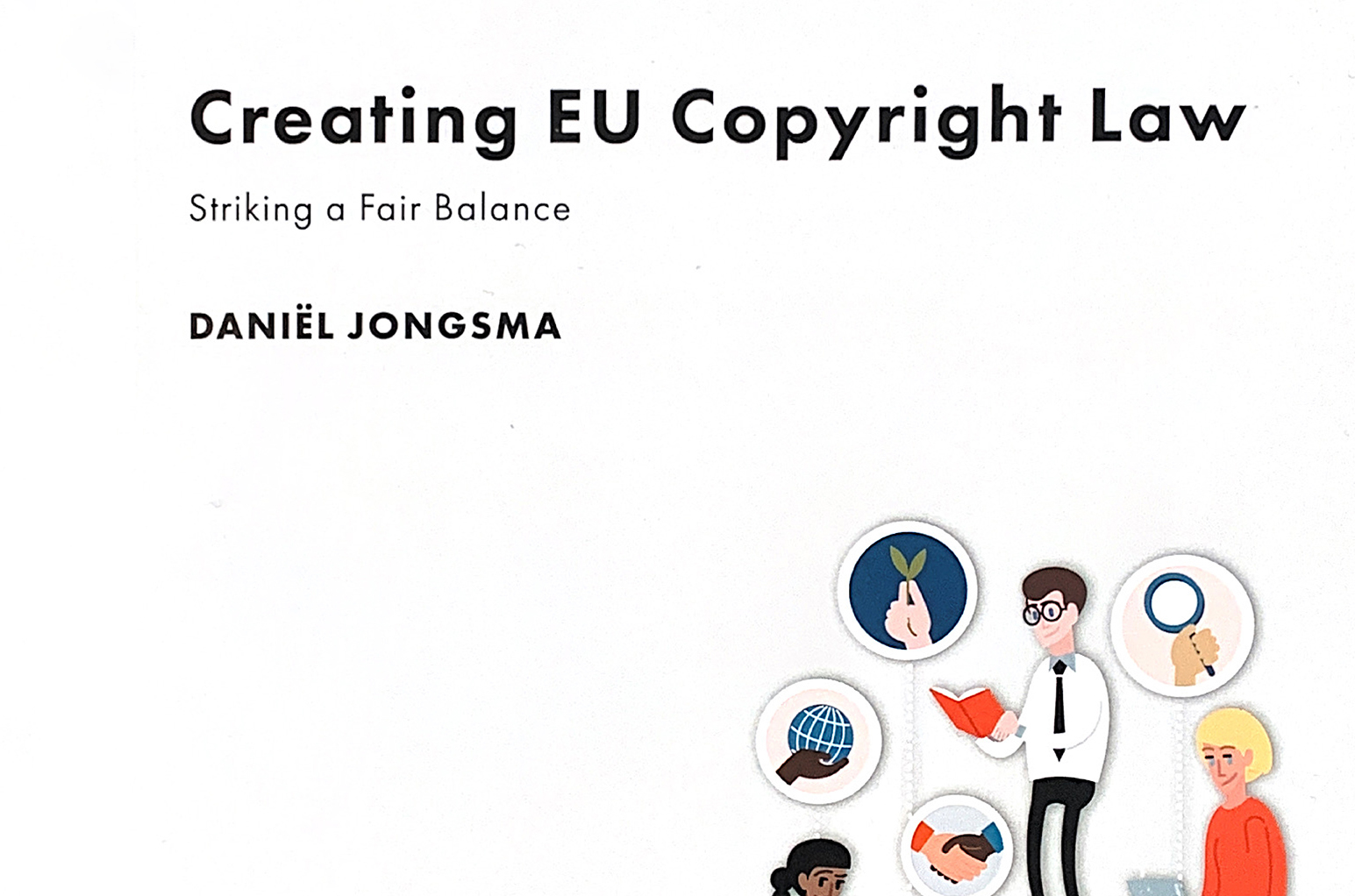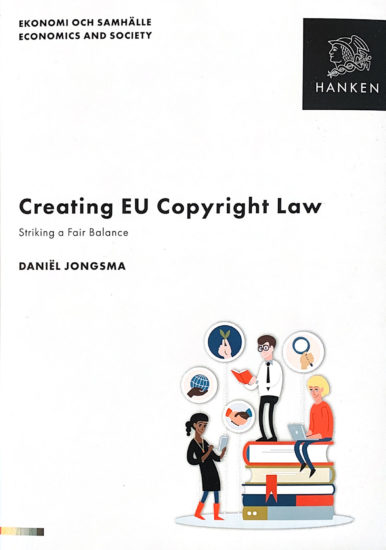Book review of Daniel Jongsma’s doctoral thesis: Creating EU Copyright Law – Striking a Fair Balance

 Book review by Professor Tuomas Mylly, University of Turku
Book review by Professor Tuomas Mylly, University of Turku
Book review of Daniel Jongsma’s doctoral thesis: Creating EU Copyright Law: Striking a Fair Balance (Hanken School of Economics 2019), xi + 257 text pages + bibliography.
In January 2020, Daniel Jongsma successfully defended his doctoral thesis Creating EU Copyright Law: Striking a Fair Balance. The opponent was Professor Jonathan Griffiths from Queen Mary University of London. Together with Griffiths I functioned as a pre-examiner. I draw from my pre-examiner’s statement but have modified it considerably for this review.
The interaction between fundamental rights and copyright has emerged as one of the major scholarly topics in European copyright law during the recent decade. The binding nature of the Fundamental Rights Charter of the EU on the constitutional level of the basic EU Treaties since December 2009 and the rapidly expanding case law of the Court of Justice of the EU (CJEU) on copyright and its relation to fundamental rights signify that this has become one of the major copyright developments in Europe. For a reader of this review having not followed CJEU’s copyright case law during the last decade, the high number of copyright judgments with substantive discussion of fundamental rights likely comes as a surprise. Whether the surprise is positive or negative depends on one’s own standpoint on the functions of fundamental rights proportionality.
However, this development has not gone unnoticed by other IP scholars in Europe: the topic has become a popular one in European legal scholarship during the recent decade. For instance, Christophe Geiger alone, one of the most prolific and well-known scholars in this area in Europe, has produced about twenty texts Jongsma refers to. The problem area chosen is thus extremely important, but at the same time the focus of the thesis could have been tighter and the theoretical framework less conventional in consideration of the already existing research on the topic.
It is fair for the reviewed work and its author – as well as the readers of this review – to expose my own standpoint on the topic at the outset. In my view, fundamental rights proportionality has mostly had troubling effects in the CJEU’s copyright case law; and there are no easy fixes (see Mylly, T.: Proportionality in the CJEU’s Internet Copyright Case Law: Invasive or Resilient?, in Ulf Bernitz and others (eds), General Principles of EU Law and the EU Digital Order (Kluwer Law International 2020). My understanding thus differs remarkably from Jongsma’s. But ours is the age of constitutional balancing – like it or not – and it has reached European copyright law during the last decade with remarkable speed and energy.
Jongsma’s mission is to offer a comprehensive and critical analysis of how the use of fundamental rights balancing impacts the (re)shaping of the scope of protection in a harmonized EU copyright law. The precise research question (p. 9) is: “What is and ought to be the role of fundamental rights in determining the scope of protection in EU copyright law?” The question is further subdivided to three preliminary questions dealing with CJEU discretion, conceptualization of balancing as such, and the meaning of fair balance as used by the CJEU. These are important, broad and theoretical questions, but they also underlie any research on the same theme. Jongsma does not place the questions in any specific cultural, economic or technological context, such as some specific creative activities, art forms, or areas of copyright business. Nor does he connect the research question to identifiable developments, such as constitutionalization of law, digitalization, private ordering, technological mediation of communication or similar meta-trends. Instead, the research question relates to the normative level of European copyright law in general and in toto.
This means that – although being limited to European copyright – the material focus of the research appears very broad in scope and abstract in nature in the sense of not being connected to any specific cultural, technological, economic or social context.
Jongsma wholeheartedly endorses proportionality as a method. He accepts the bulk of CJEU’s related copyright case law, although he sees grounds to develop it in terms of reasoning, among others. He agrees with much recent copyright scholarship seeing no basic problem with proportionality. Hence, despite presenting some criticisms, no overarching critical perspective emerges. Such an overarching critical perspective could have produced a more focused thesis in the sense of enabling the reading of the case law and mainstream copyright scholarship discussing it from a focused (critical) angle, whatever the contents of that critical angle might have been in practice. Of course, a critical viewpoint cannot be imposed on anyone. But when the absence of an overarching critical perspective is combined with the broad material focus and other methodological premises of the thesis, it becomes hard to surprise or produce a novel overall thesis.
Nevertheless, the thesis is very informative and knowledgeable. It manages to produce useful results through diligent doctrinal research and well-executed implementation. The treatment of case law is comprehensive and up to date. It not only goes through the relevant case law of the CJEU and the European Court of Human Rights (ECtHR) in detail, but also analyses domestic case law from several European jurisdictions. The thesis is rich in references to legal scholarship. Moreover, it also discusses balancing and proportionality from a legal theoretical perspective. This is still unconventional for legal scholarship on intellectual property or almost any material field of law. However, here Jongsma could have engaged more emphatically with contributions from scholars having produced detailed – and in the opinion of the current reviewer – compelling critiques of proportionality and balancing as decision-making methods. They come from names such as Grégoire Webber, Francisco Urbina and Timothy Endicott. Such writers (among others) could have provided new light to some of Jongsma’s statements on incommensurability, proportionality and balancing, which now mostly reflect writings of theorists advocating – and seeing no alternative for – the use of proportionality and balancing, such as Robert Alexy and Aharon Barak.
From the above research premises, Jongsma manages to present a logically and systematically progressing thesis, rich of up-to-date case law analyses and discussion of views presented in scholarly literature. The results are documented according to the relevant academic conventions. The thesis is written and presented exceptionally clearly and understandably.
The results reflect the potential of legal positivist research genre. Jongsma has conducted the doctrinal and case law analysis well. In particular, he makes recommendations on the way fundamental rights should be used in the interpretation of copyright, instead of for instance by relying on the notions of broad or narrow interpretation. He discusses the potential of fundamental rights analysis especially as regards remedies. He manages to produce new recommendations, interpretations and also criticism of case law developments and views presented in existing scholarship. He could certainly have gone further in his critiques by also illuminating the darker side of rights proportionality, especially as a method to develop material copyright law. He could also have substantiated how the theoretical framework he constructed could be applied to concrete problems of copyright more systematically. Doing all this in such a broad research agenda is obviously too much to ask even from a very promising researcher like Jongsma obviously is.
Overall, Jongsma’s thesis is based on a thorough research of CJEU case law on copyright and its interaction with fundamental rights. He demonstrates considerable expertise on European copyright law and its connections to fundamental rights. The thesis is exceptionally rich in its case law and secondary literature analyses. Although not producing new alternative groundbreaking perspectives on how to approach the studied phenomena, it is a must-read for anyone interested in how European copyright law has recently developed in the case law of the CJEU and – within this case law – through creative use (and in the reviewer’s view also abuse) of fundamental rights.
Writer: Tuomas Mylly (tuomyl@utu.fi)
Professor, University of Turku, Faculty of Law




